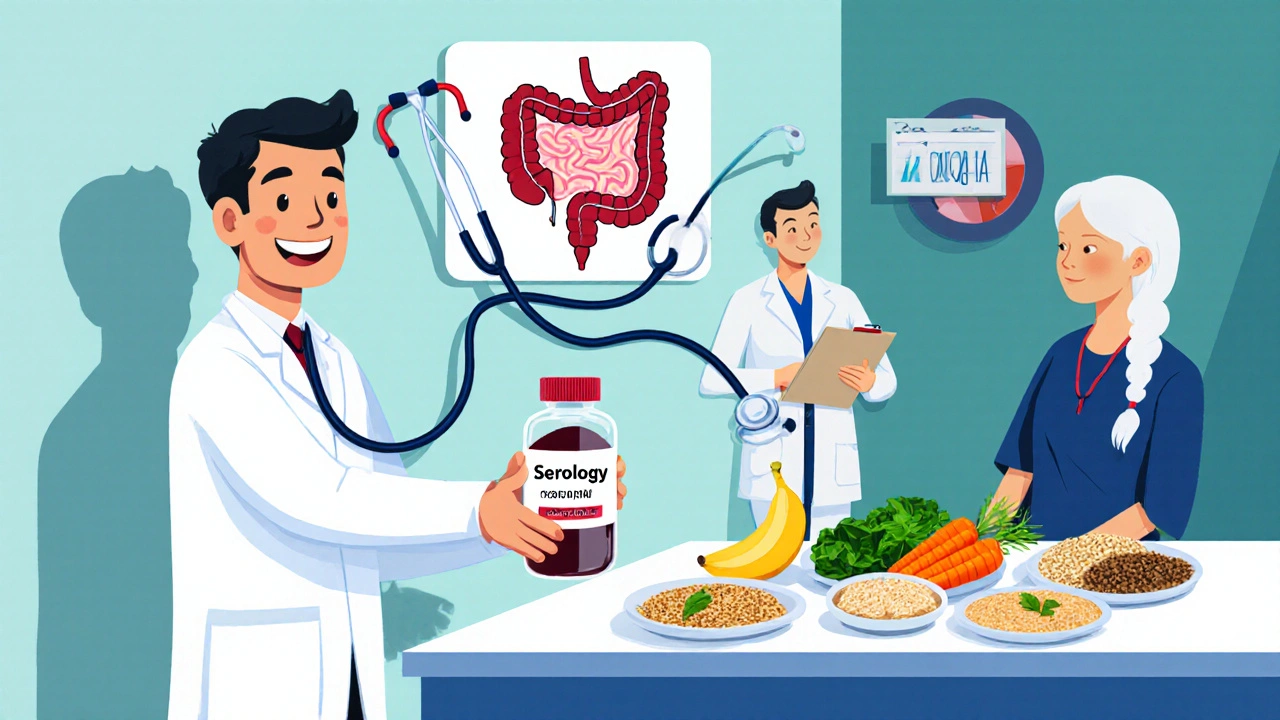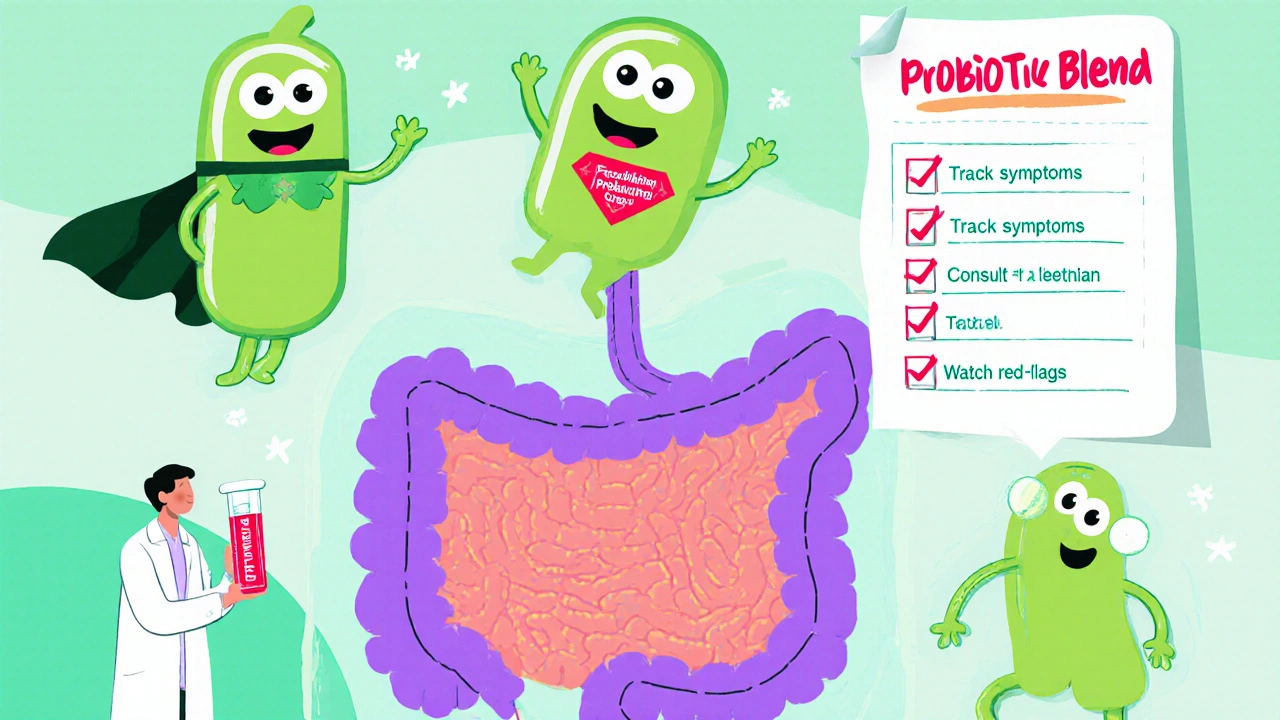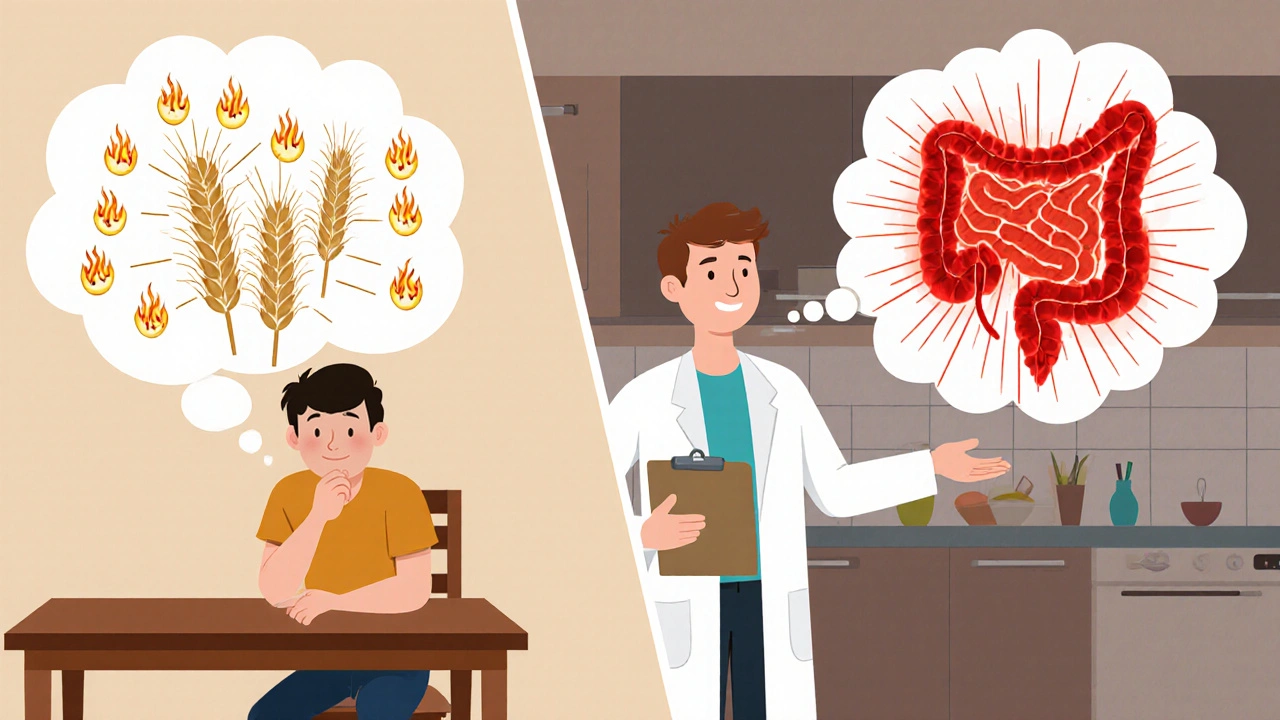Crohn's Disease Gluten Sensitivity Tracker
Track Your Symptoms & Meals
Log meals, gluten exposure, and symptoms to identify potential gluten triggers.
Tracking Summary
No data logged yet. Start by recording your meals and symptoms.
Personalized Guidance
Your symptom patterns will appear here as you log entries. When your trigger score reaches 3-4, consider consulting a dietitian about a supervised gluten challenge.
Many people with Crohn's disease wonder whether gluten could be worsening their flare‑ups. While the two conditions aren’t the same, they share enough symptoms that the overlap can be confusing. This guide breaks down what to watch for, how to test, and practical ways to adjust your diet without missing essential nutrients.
Quick Takeaways
- Gluten can trigger symptoms in some Crohn's patients, but it’s not a universal cause.
- Distinguishing Crohn's flare‑ups from gluten‑related reactions requires specific tests and careful symptom tracking.
- A targeted low‑FODMAP or gluten‑reduced diet can help, especially when guided by a dietitian.
- Watch for red‑flag signs like unexplained weight loss, blood in stool, or persistent fever-these need medical attention.
- Regular monitoring with endoscopy and serology can clarify whether gluten is a factor.
What Exactly Is Crohn's Disease?
Crohn's disease is a chronic inflammatory bowel disease (IBD) that can affect any part of the gastrointestinal tract, from mouth to anus. It causes ulcerations, strictures, and deep tissue inflammation, leading to abdominal pain, diarrhea, and fatigue. The disease results from a complex interplay of genetics, an overactive immune response, and environmental triggers.
Defining Gluten Intolerance
Gluten intolerance (also called non‑celiac gluten sensitivity) refers to a range of gastrointestinal and extra‑intestinal symptoms that improve when gluten is removed, without the autoimmune markers seen in celiac disease.
How Gluten Intolerance Differs From Celiac Disease
Celiac disease is an autoimmune disorder where ingestion of gluten triggers an immune attack on the small‑intestine lining, causing villous atrophy and malabsorption. Unlike celiac disease, gluten intolerance does not produce the same antibodies (tTG‑IgA) or intestinal damage, making diagnosis more challenging.
Why the Overlap Confuses Patients
Both Crohn's disease and gluten‑related conditions can cause abdominal pain, bloating, diarrhea, and weight loss. In fact, studies show that up to 30% of Crohn's patients report symptom relief after a gluten‑free trial, though only a fraction have measurable gluten sensitivity. The gut microbiome also plays a role; dysbiosis seen in Crohn's can amplify reactions to gluten proteins.

Key Symptoms to Track
When you’re trying to decide whether gluten is a trigger, keep a symptom diary that notes:
- Meal composition (especially wheat, barley, rye).
- Timing of symptom onset (within 30minutes, 2‑4hours, or next day).
- Severity rating (mild, moderate, severe).
- Associated extra‑intestinal signs-headaches, joint pain, brain fog.
Red‑flag symptoms that warrant immediate medical review include persistent blood in stool, high fevers, rapid weight loss, and new onset anemia.
Testing: From Blood Work to Endoscopy
Because gluten intolerance lacks a definitive biomarker, a layered testing approach works best.
- Serology: While celiac disease is confirmed with tissue transglutaminase IgA (tTG‑IgA) and endomysial antibodies, a negative result doesn’t rule out gluten intolerance.
- Genetic testing: HLA‑DQ2/DQ8 are present in most celiac patients; their absence makes celiac unlikely, but they don’t predict non‑celiac gluten sensitivity.
- Endoscopy: Endoscopy with biopsy can assess mucosal healing in Crohn's and differentiate celiac‑related villous atrophy.
- Gluten challenge: After a strict 4‑week gluten‑free period, re‑introducing gluten under medical supervision can confirm symptom correlation.
Diet Strategies That Work
Rather than a blanket gluten‑free diet, many clinicians recommend a step‑wise approach.
- Low‑FODMAP trial: Since fermentable carbs can mimic gluten symptoms, a 2‑week low‑FODMAP diet often clarifies the culprit.
- Targeted gluten reduction: If symptoms improve, eliminate wheat, barley, and rye while keeping oats (certified gluten‑free) to preserve fiber.
- Anti‑inflammatory focus: Emphasize omega‑3 rich foods (salmon, flaxseed), turmeric, and probiotic‑rich yogurt to support gut healing.
- Monitor nutrient intake: Gluten‑free products can be low in iron, B vitamins, and fiber; supplement as needed under dietitian guidance.
Comparison of Crohn's Disease, Celiac Disease, and Gluten Intolerance
| Feature | Crohn's Disease | Celiac Disease | Gluten Intolerance |
|---|---|---|---|
| Category | Inflammatory bowel disease | Autoimmune enteropathy | Non‑celiac gluten sensitivity |
| Primary trigger | Genetic + immune dysregulation | Gluten‑driven autoimmunity | Gluten (no autoimmunity) |
| Diagnostic marker | Endoscopic ulcerations, imaging | tTG‑IgA antibodies, villous atrophy | Symptom response to gluten challenge |
| Typical symptoms | Abdominal pain, diarrhea, weight loss | Diarrhea, bloating, anemia | Bloating, fatigue, brain fog |
| Long‑term risks | Strictures, fistulas, cancer risk | Osteoporosis, lymphoma | Generally low; may affect quality of life |

Practical Checklist for Patients
- Record every meal and symptom for at least two weeks.
- Schedule serology and, if indicated, an endoscopy with your gastroenterologist.
- Try a 4‑week low‑FODMAP diet before cutting gluten completely.
- If improvement occurs, re‑introduce gluten under supervision to confirm sensitivity.
- Work with a registered dietitian to ensure balanced nutrition.
- Report any alarm signs-blood in stool, fever, rapid weight loss-immediately.
When to Seek Professional Help
If you notice any of the following, book an appointment promptly:
- Persistent abdominal pain >2weeks despite dietary changes.
- Unexplained weight loss >5% of body weight.
- Visible blood or black‑tarry stools.
- Fever >38°C lasting more than 48hours.
Early intervention can prevent complications like strictures or malnutrition.
Future Directions in Research
Emerging studies are exploring the gut microbiome’s role in modulating gluten reactions among Crohn's patients. Probiotic blends targeting specific strains (e.g.,Faecalibacterium prausnitzii) show promise in reducing inflammation and possibly lessening gluten‑related symptom spikes. Keep an eye on clinical trials that combine microbiome therapy with tailored diets.
Frequently Asked Questions
Can a gluten‑free diet cure Crohn's disease?
No. Gluten‑free eating may relieve certain symptoms for some patients, but Crohn's disease is driven by immune and genetic factors that require medication and comprehensive management.
How long should I stay gluten‑free before testing effectiveness?
A minimum of four weeks is generally recommended. This allows the gut lining to reset and any lingering gluten‑related inflammation to subside.
Is it safe to self‑diagnose gluten intolerance without lab tests?
Self‑diagnosis can lead to missed nutrient deficiencies or delayed treatment for Crohn's flare‑ups. Consulting a gastroenterologist for serology, possible endoscopy, and a supervised gluten challenge is the safest route.
Do I need a special dietitian if I have both Crohn's and gluten sensitivity?
Absolutely. A dietitian experienced in IBD can balance low‑residue, anti‑inflammatory foods while ensuring you get enough fiber, iron, and B‑vitamins that gluten‑free products often lack.
What other foods can trigger symptoms similar to gluten?
High‑FODMAP items like onions, garlic, and certain fruits can cause bloating and diarrhea. Lactose, artificial sweeteners, and highly processed fats are also common culprits for IBD patients.

Laurie Princiotto
October 15, 2025 AT 20:14I guess gluten is the villain in every Crohn's story 🙄.
Suman Wagle
October 20, 2025 AT 11:21It’s fascinating how we chase dietary culprits like gluten while the immune system throws a tantrum anyway. One could argue that blaming a grain is a convenient narrative, but the reality is far messier. Still, if a four‑week trial calms the storm, why not give it a shot? After all, the gut is a stubborn negotiator that loves to keep us guessing.
Neil Sheppeck
October 25, 2025 AT 02:28Hey folks, navigating Crohn’s and gluten can feel like walking a tightrope over a volcano. I’ve seen patients thrive on a low‑FODMAP runway before even touching the gluten switch, and the color‑coded food logs really help map out the hidden triggers. Remember, the goal isn’t to starve the gut but to give it a gentle handshake of kindness. Keep the meals bright, the fibers friendly, and don’t forget a splash of turmeric for the drama‑loving inflammation.
Rohinii Pradhan
October 29, 2025 AT 17:34While the article outlines the overlap succinctly, one must emphasize that serological negativity does not equate to clinical insignificance. The nuanced distinction between celiac autoimmunity and non‑celiac gluten sensitivity warrants rigorous double‑blind challenges under supervision. Moreover, the microbiome’s fermentative capacity can amplify gluten‑related discomfort independent of adaptive immunity. Hence, a multidisciplinary approach, integrating gastroenterology, dietetics, and microbiology, remains paramount.
Anna-Lisa Hagley
November 3, 2025 AT 08:41The data presented is comprehensive, yet the practical application often falls short when patients lack access to qualified dietitians. A systematic bias toward pharmacologic interventions can eclipse the subtle benefits of dietary modulation. In my experience, a reserved analytical lens reveals that even minor grain reductions can shift the symptom curve, provided the nutrient gaps are meticulously back‑filled.
A Walton Smith
November 7, 2025 AT 23:48Short term gluten cuts can help but watch nutrient loss.
Theunis Oliphant
November 12, 2025 AT 14:54One must recognize the sheer audacity of proclaiming gluten as the universal antagonist. Such proclamations betray a simplistic worldview that neglects the intricate symphony of immunologic and microbial actors at play. The pretentious rhetoric, while dramatic, ultimately diminishes the lived reality of those battling relentless inflammation.
India Digerida Para Occidente
November 17, 2025 AT 06:01Indeed, embracing a step‑wise dietary trial can empower patients to reclaim agency over their gut health. By coupling a low‑FODMAP foundation with a monitored gluten re‑challenge, clinicians can delineate the true impact of gluten on a case‑by‑case basis. This assertive yet compassionate strategy respects individual variability while maintaining scientific rigor.
Andrew Stevenson
November 21, 2025 AT 21:08From a clinical nutrition perspective, the interplay between Crohn's disease pathophysiology and gluten exposure is multifactorial, necessitating a granular, evidence‑based algorithm. First, prioritize a comprehensive baseline assessment encompassing serologic panels, HLA typing, and detailed anthropometric metrics to establish a robust reference point. Second, initiate a structured low‑FODMAP protocol for a minimum of two weeks, meticulously documenting macronutrient ratios, fiber sources, and symptom indices using validated scoring tools such as the CDAI and GSRS. Third, upon stabilization, introduce a supervised gluten challenge, ensuring the re‑introduction is incremental (e.g., 5 g per day) and monitored with bi‑daily symptom logs to capture latency patterns. Fourth, integrate targeted probiotic supplementation-specifically strains like Faecalibacterium prausnitzii and Akkermansia muciniphila-to potentially attenuate dysbiosis‑driven inflammation, as emerging meta‑analyses suggest synergistic benefits when paired with anti‑inflammatory diets. Fifth, assess micronutrient status at the conclusion of the trial, focusing on iron, vitamin D, B‑12, and folate, given the known deficits associated with both gluten‑free processed foods and Crohn's‑related malabsorption. Sixth, synthesize the data into a personalized dietary roadmap, balancing low‑residue considerations for disease flares with fiber‑rich, anti‑oxidant‑dense foods during remission phases. Finally, schedule longitudinal follow‑up appointments at 3‑month intervals to recalibrate the nutritional plan based on disease activity, patient tolerance, and emerging research, thereby fostering a dynamic, patient‑centred care model that transcends static dietary dogma.
Kate Taylor
November 26, 2025 AT 12:14I appreciate the depth of the protocol outlined above; it mirrors the collaborative mindset we aim for in multidisciplinary clinics. Ensuring patients receive clear, actionable steps while monitoring nutrient adequacy is essential, especially when gluten‑free alternatives may lack iron and B‑vitamins. Let’s keep the dialogue open and prioritize patient education.
Hannah Mae
December 1, 2025 AT 03:21Honestly, the whole gluten craze feels overblown when you think about the real triggers in Crohn's.
Iván Cañas
December 5, 2025 AT 18:28There’s value in both the scientific rigor and the everyday practicality of these recommendations. While the formal steps provide a solid framework, it’s also okay to simplify the language for patients who feel overwhelmed. Balancing thoroughness with accessibility helps ensure adherence without sacrificing quality of care.